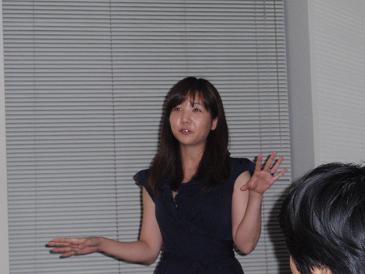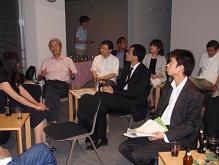代官山ステキサロン第4回:Daikanyama Suteki Salon 4th Meeting [イベント情報]
「代官山ステキサロン」:Daikanyama Suteki Salon
第4回会合(2008/08/04):4th Meeting
於ヒルサイドテラスE棟ロビー:@Lobby of Hillside Terrace E
テーマ:「ディスポジション:まちづくりの可能性」
Topic: “Disposition: Application in Town Development"
講師:柳澤田実(南山大学人文学部専任講師)
Speaker: Tami Yanagisawa (Lecturer, Nanzan University)

「ディスポジション:よりよく生きるために」
今回の代官山ステキサロンでは、初めて外部から講師を招待しましたが、それはステキ総研のメンバー以外からという意味だけでなく、街づくりの分野以外からの専門家という意味でもあります。講師は哲学分野の柳澤田実南山大学専任講師で、最近の編著書『ディスポジション:配置としての世界』(以下の「文献」参照)の内容に即して「ディスポジション」に関するプレゼンが行われました。
ディスポジションとは文字通り配置、離して置くことですが、そこから転じて配置により生じる傾向性、習慣、力、気質といった意味もあります。この世界は配置であり、人間は自らを取り巻く配置によって絶えず態勢づけられて(disposeされて)おり、そこでは内的な力、傾向、気質、態勢などが、生活上の行動を通じて配置され、様々な分野、例えば政治、倫理、経済、技術、芸術といった複雑な形に再配置されています。このような「配置」(disposition)は、世界をボトムアップ的に見る見方で、これに対して、私たちがしばしば自分自身の理念や価値を持って現実世界を上から捉える「構成」(composition)は、世界をトップダウン的に見る見方といえます。
配置による見方が目指すことは、「世界のすべてが何らかの前提条件によって作られた配置と可能性の連続態でしかないという現実を認めること」、および「私たちがそこに介入する場合は潜在する可能性を無視することなく、さらに多くの可能性を生み出すような再配置を目指すこと」で、それが私たちにとってより「良く」生きる可能性を導くことになります(「ファーレ立川」がその一つの例で、以下の「文献」参照)。配置という見方は、私たちの「良い、悪い」といった価値そのものを捉えなおして、実在にフィットした無数の現実や概念に基づいて「より良い」生活の可能性を生むことに役立つと思われます。
この配置という考え方は、前回のステキサロンで野呂教授が指摘された代官山のような望ましい町づくりのための「新しいコミュニテイの形成」にとって方法論的な根拠を提供するものではないかと感じた次第です(以下を参照:http://daikanyama.blog.so-net.ne.jp/archive/200802-1)。
以上のようなプレゼンの後のフリーディスカッションでは、いくつかの重要な質問が提起されました。例えば、「私たちが代官山が『良い町』という場合に、それは下からの配置の見方の結果か、それとも上からの構成の見方の結果か」、また「配置という見方は、はたして都市再開発の枠組みやメカニズムとして十分なものかどうか、特に大震災のような災害後の町の再建において十分機能するのかどうか」といった質問をめぐり熱い議論が数時間も展開され、真夜中近くまで続きました。
文献:References:
柳澤田実編『ディスポジション:配置としての世界』
Tami Yanagisawa ed., “Disposition View of the World”
http://utcp.c.u-tokyo.ac.jp/from/blog/2008/06/post-97/
「ファーレ立川」:Faret Tachikawa:
http://www.gws.ne.jp/tama-city/faret/faret.html
Disposition: For Our Better Living
At the Daikanyama Suteki Salon, this is the first time a lecturer was invited from outside, not just from outside of the Suteki Research Institute members, but also from outside of the urban development field. Ms. Tami Yanagiwasa, researcher in philosophy and lecturer at Nanzan University, made a presentation on “disposition,” based on her recently edited book “Disposition View of the World” (see the References). The following is a summary of her presentation.
Disposition literally means placing or arrangement, and also implies tendency, inclination, power, temper or character that results from a particular arrangement. The world is nothing but disposition in this sense, and human beings are constantly disposed (regulated) by the disposition surrounding themselves, where internal power, temper, tendency, etc. are being organized and reorganized into various disciplines such as politics, ethics, economics, technology and arts through actions in human life. Disposition is this kind of “bottom-up” view of the world, whereas composition is a “top-down” view that we often take by imposing our own values or norms in grasping the real world.
By subscribing to the disposition view, we would accept the real world as a continuum of possibilities of disposition evolving from certain initial conditions, not as a snapshot with no history or background. We should also seek a kind of reorganization or repositioning that could expand possibilities without ignoring existing possibilities of disposition, leading to a “better” way of living (“Faret Tachikawa” is one of those examples, for which see the Reference). The disposition view will help us redefine our values to seek the possibility of a better life based on numerous facts and concepts that fit the real world, according to Ms. Yanagisawa.
It seems that this disposition approach might well provide a methodological ground for creation of new communities to develop desirable cities like Daikanyama, as Prof. Noro suggested at the previous Suteki Salon meeting (see: http://daikanyama.blog.so-net.ne.jp/archive/200802-1).
In the free discussion session, a number of important questions were raised such as “does our view on Daikanyama as a ‘good’ place result from the disposition approach or the composition approach?” and “is the disposition view enough to provide an effective framework or mechanism for community redevelopment, especially in the aftermath of some natural disaster like an earthquake?” A heated discussion continued for a couple of hours, close to midnight.
参加者との自由討論:Free Discussion with Participants


第4回会合(2008/08/04):4th Meeting
於ヒルサイドテラスE棟ロビー:@Lobby of Hillside Terrace E
テーマ:「ディスポジション:まちづくりの可能性」
Topic: “Disposition: Application in Town Development"
講師:柳澤田実(南山大学人文学部専任講師)
Speaker: Tami Yanagisawa (Lecturer, Nanzan University)
「ディスポジション:よりよく生きるために」
今回の代官山ステキサロンでは、初めて外部から講師を招待しましたが、それはステキ総研のメンバー以外からという意味だけでなく、街づくりの分野以外からの専門家という意味でもあります。講師は哲学分野の柳澤田実南山大学専任講師で、最近の編著書『ディスポジション:配置としての世界』(以下の「文献」参照)の内容に即して「ディスポジション」に関するプレゼンが行われました。
ディスポジションとは文字通り配置、離して置くことですが、そこから転じて配置により生じる傾向性、習慣、力、気質といった意味もあります。この世界は配置であり、人間は自らを取り巻く配置によって絶えず態勢づけられて(disposeされて)おり、そこでは内的な力、傾向、気質、態勢などが、生活上の行動を通じて配置され、様々な分野、例えば政治、倫理、経済、技術、芸術といった複雑な形に再配置されています。このような「配置」(disposition)は、世界をボトムアップ的に見る見方で、これに対して、私たちがしばしば自分自身の理念や価値を持って現実世界を上から捉える「構成」(composition)は、世界をトップダウン的に見る見方といえます。
配置による見方が目指すことは、「世界のすべてが何らかの前提条件によって作られた配置と可能性の連続態でしかないという現実を認めること」、および「私たちがそこに介入する場合は潜在する可能性を無視することなく、さらに多くの可能性を生み出すような再配置を目指すこと」で、それが私たちにとってより「良く」生きる可能性を導くことになります(「ファーレ立川」がその一つの例で、以下の「文献」参照)。配置という見方は、私たちの「良い、悪い」といった価値そのものを捉えなおして、実在にフィットした無数の現実や概念に基づいて「より良い」生活の可能性を生むことに役立つと思われます。
この配置という考え方は、前回のステキサロンで野呂教授が指摘された代官山のような望ましい町づくりのための「新しいコミュニテイの形成」にとって方法論的な根拠を提供するものではないかと感じた次第です(以下を参照:http://daikanyama.blog.so-net.ne.jp/archive/200802-1)。
以上のようなプレゼンの後のフリーディスカッションでは、いくつかの重要な質問が提起されました。例えば、「私たちが代官山が『良い町』という場合に、それは下からの配置の見方の結果か、それとも上からの構成の見方の結果か」、また「配置という見方は、はたして都市再開発の枠組みやメカニズムとして十分なものかどうか、特に大震災のような災害後の町の再建において十分機能するのかどうか」といった質問をめぐり熱い議論が数時間も展開され、真夜中近くまで続きました。
文献:References:
柳澤田実編『ディスポジション:配置としての世界』
Tami Yanagisawa ed., “Disposition View of the World”
http://utcp.c.u-tokyo.ac.jp/from/blog/2008/06/post-97/
「ファーレ立川」:Faret Tachikawa:
http://www.gws.ne.jp/tama-city/faret/faret.html
Disposition: For Our Better Living
At the Daikanyama Suteki Salon, this is the first time a lecturer was invited from outside, not just from outside of the Suteki Research Institute members, but also from outside of the urban development field. Ms. Tami Yanagiwasa, researcher in philosophy and lecturer at Nanzan University, made a presentation on “disposition,” based on her recently edited book “Disposition View of the World” (see the References). The following is a summary of her presentation.
Disposition literally means placing or arrangement, and also implies tendency, inclination, power, temper or character that results from a particular arrangement. The world is nothing but disposition in this sense, and human beings are constantly disposed (regulated) by the disposition surrounding themselves, where internal power, temper, tendency, etc. are being organized and reorganized into various disciplines such as politics, ethics, economics, technology and arts through actions in human life. Disposition is this kind of “bottom-up” view of the world, whereas composition is a “top-down” view that we often take by imposing our own values or norms in grasping the real world.
By subscribing to the disposition view, we would accept the real world as a continuum of possibilities of disposition evolving from certain initial conditions, not as a snapshot with no history or background. We should also seek a kind of reorganization or repositioning that could expand possibilities without ignoring existing possibilities of disposition, leading to a “better” way of living (“Faret Tachikawa” is one of those examples, for which see the Reference). The disposition view will help us redefine our values to seek the possibility of a better life based on numerous facts and concepts that fit the real world, according to Ms. Yanagisawa.
It seems that this disposition approach might well provide a methodological ground for creation of new communities to develop desirable cities like Daikanyama, as Prof. Noro suggested at the previous Suteki Salon meeting (see: http://daikanyama.blog.so-net.ne.jp/archive/200802-1).
In the free discussion session, a number of important questions were raised such as “does our view on Daikanyama as a ‘good’ place result from the disposition approach or the composition approach?” and “is the disposition view enough to provide an effective framework or mechanism for community redevelopment, especially in the aftermath of some natural disaster like an earthquake?” A heated discussion continued for a couple of hours, close to midnight.
参加者との自由討論:Free Discussion with Participants
2008-08-05 06:41
nice!(0)
コメント(0)
トラックバック(0)




コメント 0